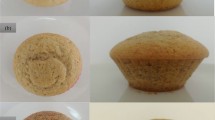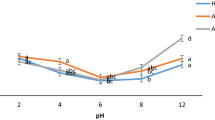Abstract
Globally, edible insects are increasingly being recognised as an alternative to animal protein source. However, the effect of heat-processing methods on the insects’ nutritional value has not been extensively studied for most edible insects. The effect of thermal processing on proximate and dietary fibre composition of the edible ground cricket, Henicus whellani Chopard, was investigated at different exposure periods for roasting and wet-heating (0, 15, 30 and 60 min); and for microwaving (2 and 5 min). Moisture, ash, crude fat and crude protein were determined using standard proximate analysis methods whilst dietary fibre fractions were determined using the enzymatic gravimetric method. Highest crude protein content (67.6%) was observed after microwaving for 5 min. Crude fat was highest (10.7%) after wet-heating at 95 °C for 60 min. The highest ash content (5.1%) was attained after wet-heating at 95 °C for 30 min. All thermal processes resulted in significant increase in soluble dietary fibre fractions. The highest soluble dietary fibre (5.78 g/100 g) was obtained after roasting for 60 min at 60 °C. Roasting at a lower temperature for shorter time (60 °C for 15 min) resulted in higher insoluble dietary fibre (8.70 g/100 g) than at a higher temperature and longer time (80 °C for 30 min)(3.72 g/100 g). The highest total dietary fibre (13.81 g/100 g) was obtained after roasting for 60 min at 60 °C while the lowest fibre level (4.66 g/100 g) was obtained after roasting for 30 min at 80 °C. Microwaving (for 5 min), wet-heating (95 °C for 60 min), wet-heating (95 °C for 30 min) and roasting (60 °C for 60 min) resulted in the highest retention of protein, fat, ash and total dietary fibre; respectively. The evaluated time-temperature combinations are recommended for insect processing to achieve protein, fat, ash and dietary fibre fractions suitable for human consumption.
Similar content being viewed by others
References
Abraha B, Admassu H, Mahmud A, Tsighe N, Shui XW, Fang Y (2018) Effect of processing methods on nutritional and physico-chemical composition of fish: a review. MOJ Food Proc Technol 6:376–382
Ajila CM, Prasada-Rao UJS (2013) Mango peel dietary fibre: composition and associated bound phenolics. J Funct Foods 5:444–450
AOAC (Association of Official Analytical Chemists) (1995) Total, soluble and insoluble dietary fibre in foods. AOAC official method 991.43. In official methods of analysis, 16th edn. AOAC, Washington, DC
AOAC (Association of Official Analytical Chemists) (1997) Official methods of analysis, 17th edn. Association of Official Analytical Chemists, Washington, DC, p 807928
Caprita A, Caprita R, Simulescu VO, Drehe RM (2011) The effect of temperature on soluble dietary fibre fraction in cereals. J Agroaliment Process Technol 17:214–217
Chakravorty J, Gosh S, Jung C, Meyer-Rochow VB (2014) Nutritional composition of Chondacris rosea and Brachytrupes orientalis: two common insects used as food by tribes of Arunachal Pradesh, India. J Asia Pac Entomol 17:407–415
Chandrasiri SD, Liyanage R, VidanarachchiJK Weththasinghe P, Jayawardana BC (2016) Does processing have a considerable effect on the nutritional and functional properties of mung bean (Vigna radiata)? Procedia Food Sci 6:352–355
Colin-Henrion M, Mehinagic E, Renard CMGC, Richomme P, Jourjon F (2009) From apple to applesauce: processing effects on dietary fibres and cellwall polysaccharides. Food Chem 117:254–260
Dhingra D, Michael M, Rajput H, Patil RT (2012) Dietary fibre in foods: a review. J Food Sci Technol 49:255–266
Ekpo EK (2011) Effect of processing on the protein quality of four popular insects consumed in southern Nigeria. Arch Appl Sci Res 3:307–326
FAO, Biodiversity International (2017) Guidelines on Assessing Bio-diverse Foods in dietary intake surveys. Food and Agriculture Organization of the United Nations (FAO), Rome, Italy
Feng Y, Chen XM, Zhao M, He Z, Sun L, Wang CY, Ding WF (2018) Edible insects in China: utilization and prospects. Insect Science 25:184–198
Garcia-Amezquita LE, Tejada-Ortigoza V, Serna-Saldivar SO, Welti-Chanes J (2018) Dietary fibre concentrates from fruit and vegetable by-products: processing, modification, and application as functional ingredients. Food Bioproc Technol Int J 6:1–25
Glover D, Sexton A (2015) Edible insects and the future of food: a foresight scenario exercise on Entomophagy and global food security. Inst Dev Stud 149:1–57
Kim TK, Yong HI, Kim YB, Hyun-Wook Kim HW, Choi YS (2019) Edible insects as a protein source: a review of public perception, processing technology, and research trends. Food Sci Anim Resour 39:521–540
Kinyuru JN, Mogendi JB, Riwa CA, Ndung’u NW (2015) Edible insects—a novel source of essential nutrients for human diet: learning from traditional knowledge. Anim Front 5:14–19
Kourimska L, Adamkova A (2016) Nutritional and sensory quality of edible insects. Nutr Food Sci J 4:22–26
Kroncke N, Grebenteuch S, Keil C, Demtroder S, Kroh L, Thunemann AF, Benning R, HajoHaase H (2019) Effect of different drying methods on nutrient quality of the yellow mealworm (Tenebrio molitor L.). Insects 10:1–14
Kunatsa Y, Chidewe C, Zvidzai CJ (2020) Phytochemical and anti-nutrient composite from selected marginalized Zimbabwean edible insects and vegetables. J Agric Food Res 2. https://doi.org/10.1016/j.jafr.2020.100027
Mancini S, Moruzzo R, Riccioli F, Paci G (2019) European consumers’ readiness to adopt insects as food. A review. Food Res Int 122:661–678
Manditsera FA, Luning PA, Fogliano V, Lakemond CMM (2019) The contribution of wild harvested edible insects (Eulepida mashona and Henicus whellani) to nutrition security in Zimbabwe. J Food Compos Anal 75:17–25
Megazyme International (2016) Available carbohydrates and dietary fibre - assay procedure. Ireland
Melgar-Lalanne G, Hernandez-Alvarez A, Salinas-Castro A (2019) Edible insects processing: traditional and innovative technologies. Compr Rev Food Sci Food Saf 18:1166–1191
Musundire R, Zvidzai CJ, Chidewe C, Samende BK, Chemura A (2016) Habitats and nutritional composition of selected edible insects in Zimbabwe. J Insects Food Feed 2:189–198
Musundire R, Zvidzai CJ, Manditsera FA, Chidewe C, Samende BK (2014) Nutrient and anti-nutrient composition of Henicus whellani (Orthoptera: Stenopelmatidae), an edible ground cricket, in South-Eastern Zimbabwe. Int J Trop Ins Sci 34:223–231
Nyman EMGL, Svanberg SJM, Andersson R, Nilsson T (2005) Effects of cultivar, root weight, storage and boiling on carbohydrate content in carrots (Daucus carota L). J Sci Food Agric 85:441–449
Ozyurt VH, Otles S (2016) Effect of food processing on the physicochemical properties of dietary fibre. Acta Sci Pol Technol Aliment 15:233–245
Perez-Hidalgo M, Guerra-Hernandez E, Garcia-Villanova B (1997) Determination of insoluble dietary fibre compounds: cellulose, hemicellulose and lignin in legumes. Ars Pharmaceutica 38:357–364
Purschke B, Bruggen H, Scheibelberger R, Jager H (2017) Effect of pre-treatment and drying method on physico-chemical properties and dry fractionation behaviour of mealworm larvae (Tenebriomolitor L.). Eur Food Res Technol 8:1–12
Rehman Z, Islam M, Shah WH (2003) Effect of microwave and conventional cooking on insoluble dietary fibre components of vegetables. Food Chem 80:237–240
Rehman Z, Shah WH (2004) Domestic processing effects on some insoluble dietary components of various food legumes. Food Chem 87:613–617
da Silva Lucasa AJ, de Oliveira LM, da Rocha M, Prentice C (2020) Edible insects: an alternative of nutritional, functional and bioactive compounds. Food Chem 311:1–11
Srivastava RP, Vasishtha H (2013) Dehusking and cooking effect on dietary fibre, soluble protein and Lectin of lentils (Lens culinaris). Indian J Agric Biochemi 26:36–40
Van Huis A, Itterbeeck JV, Klunder H, Mertens E, Halloran A, Muir G, Vantomme P (2013) Edible insects: future prospects for food and feed security. Food and Agriculture Organization of the United Nations, Forestry Paper, Rome, pp 171–187
WFP (2013) Protracted relief recovery operations-Zimbabwe. Agenda 8, Responding to Humanitarian Needs and Strengthening Resilience to Food security, WFP/EB.1/2013/8A/2, June 2013, Regional Bureau Johannesburg (Southern Africa)
Xiaoming C, Ying F, Hong Z, Zhiyong C (2010) Review of the nutritive value of edible insects. Insects Food. In: Durst PB, Johnson DV, Leslie RN, Shono K (eds). Proceeding of a workshop on Asia-Pacific resources and their potential for development, 19–21 February 2008, Chiang Mai, Thailand. Food and Agricultural Organization of the United Nations Regional Office for Asia and the Pacific, pp 85–92
Younes I, Rinaudo M (2015) Chitin and chitosan preparation from marine sources. Structure, properties and applications. Mar Drugs 13:1133–1174
Acknowledgements
The authors acknowledge the guidance of Professor T. Halimani of Department of Livestock Sciences, University of Zimbabwe on statistical analysis and packaging of results and Mr. V. C. Mafirakureva of National Institute of Health Research, Harare, Zimbabwe for confirming the identity of H. whellani. We thank Ms. Joyce Madanyika, for assistance with insect sample collection. Technical assistance provided by staff in the Department of Livestock Sciences, University of Zimbabwe is gratefully acknowledged. The study received no external funding.
Author information
Authors and Affiliations
Corresponding author
Ethics declarations
Conflict of interest
The authors declare no conflict of interest.
Additional information
Publisher’s note
Springer Nature remains neutral with regard to jurisdictional claims in published maps and institutional affiliations.
Rights and permissions
About this article
Cite this article
Tinarwo, J., Mvumi, B.M., Saidi, P.T. et al. Effect of heat treatment on selected macronutrients in the wild harvested edible ground cricket, Henicus whellani Chopard. Int J Trop Insect Sci 41, 2051–2058 (2021). https://doi.org/10.1007/s42690-020-00375-6
Received:
Accepted:
Published:
Issue Date:
DOI: https://doi.org/10.1007/s42690-020-00375-6




